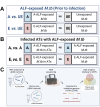Impact of the elderly lung mucosa on Mycobacterium tuberculosis transcriptional adaptation during infection of alveolar epithelial cells
- PMID: 39513699
- PMCID: PMC11619525
- DOI: 10.1128/spectrum.01790-24
Impact of the elderly lung mucosa on Mycobacterium tuberculosis transcriptional adaptation during infection of alveolar epithelial cells
Abstract
Tuberculosis is one of the leading causes of death due to a single infectious agent. Upon infection, Mycobacterium tuberculosis (M.tb) is deposited in the alveoli and encounters the lung mucosa or alveolar lining fluid (ALF). We previously showed that, as we age, ALF presents a higher degree of oxidation and inflammatory mediators, which favors M.tb replication in human macrophages and alveolar epithelial cells (ATs). Here, we define the transcriptional profile of M.tb when exposed to healthy ALF from adult (A-ALF) or elderly (E-ALF) humans before and during infection of ATs. Prior to infection, M.tb exposure to E-ALF upregulated genes essential for bacterial host adaptation directly involved in M.tb pathogenesis. During infection of ATs, E-ALF exposed M.tb further upregulated genes involved in its ability to escape into the AT cytosol bypassing critical host defense mechanisms, as well as genes associated with defense against oxidative stress. These findings demonstrate how alterations in human ALF during the aging process can impact the metabolic status of M.tb, potentially enabling a greater adaptation and survival within host cells. Importantly, we present the first transcriptomic analysis on the impact of the elderly lung mucosa on M.tb pathogenesis during intracellular replication in ATs.IMPORTANCETuberculosis is one of the leading causes of death due to a single infectious agent. Upon infection, Mycobacterium tuberculosis (M.tb) is deposited in the alveoli and comes in contact with the alveolar lining fluid (ALF). We previously showed that elderly ALF favors M.tb replication in human macrophages and alveolar epithelial cells (ATs). Here we define the transcriptional profile of when exposed to healthy ALF from adult (A-ALF) or elderly (E-ALF) humans before and during infection of ATs. Prior to infection, exposure to E-ALF upregulates genes essential for bacterial host adaptation and pathogenesis. During infection of ATs, E-ALF further upregulates M.tb genes involved in its ability to escape into the AT cytosol, as well as genes for defense against oxidative stress. These findings demonstrate how alterations in human ALF during the aging process can impact the metabolic status of M.tb, potentially enabling a greater adaptation and survival within host cells.
Keywords: Mycobacterium tuberculosis; aging; alveolar epithelial cells; alveolar lining fluid; transcriptomics.
Conflict of interest statement
The authors declare no conflict of interest.
Figures






Similar articles
-
Phagosomal escape and sabotage: The role of ESX-1 and PDIMs in Mycobacterium tuberculosis pathogenesis.Int Rev Immunol. 2025 Jul 18:1-27. doi: 10.1080/08830185.2025.2531828. Online ahead of print. Int Rev Immunol. 2025. PMID: 40679498 Review.
-
Xpert® MTB/RIF assay for extrapulmonary tuberculosis and rifampicin resistance.Cochrane Database Syst Rev. 2018 Aug 27;8(8):CD012768. doi: 10.1002/14651858.CD012768.pub2. Cochrane Database Syst Rev. 2018. Update in: Cochrane Database Syst Rev. 2021 Jan 15;1:CD012768. doi: 10.1002/14651858.CD012768.pub3. PMID: 30148542 Free PMC article. Updated.
-
Undernutrition as a risk factor for tuberculosis disease.Cochrane Database Syst Rev. 2024 Jun 11;6(6):CD015890. doi: 10.1002/14651858.CD015890.pub2. Cochrane Database Syst Rev. 2024. PMID: 38860538 Free PMC article.
-
Management of urinary stones by experts in stone disease (ESD 2025).Arch Ital Urol Androl. 2025 Jun 30;97(2):14085. doi: 10.4081/aiua.2025.14085. Epub 2025 Jun 30. Arch Ital Urol Androl. 2025. PMID: 40583613 Review.
-
Identification of Mycobacterium tuberculosis intracellular survival-related virulence factors via CRISPR-based eukaryotic-like secretory protein mutant library screen.Microbiol Spectr. 2025 Aug 5;13(8):e0076725. doi: 10.1128/spectrum.00767-25. Epub 2025 Jun 12. Microbiol Spectr. 2025. PMID: 40503836 Free PMC article.
References
-
- WHO . 2022. Ageing and health. World Health Organization.
-
- Mather M, Scommegna P, Kilduff L. 2019. Fact sheet: aging in the United States. Retrieved 15 Jul 2019.
-
- Chalise HN. 2019. Aging: basic concept. AJBSR 1:8–10. doi:10.34297/AJBSR.2019.01.000503 - DOI
Grants and funding
LinkOut - more resources
Full Text Sources
Molecular Biology Databases

